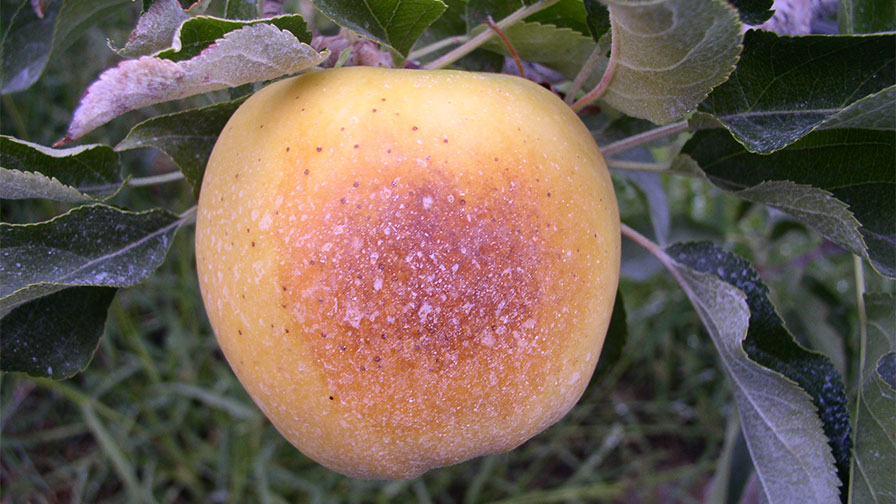How to Prevent Sunburn on Apples

This ‘Golden Delicious’ apple shows signs of sunburn necrosis. (Photo: Tory Schmidt)
Byron Phillips National Crop Specialist for Valent, says most of the problems he saw last year are the result of heat.
“I think the extensive period of heavy smoke over the region during the hottest part of the summer pretty effectively reduced sunburn from light exposure but did not reduce related disorders resulting from heat exposure,” he says.
According to Rob Blakey, formerly of Washington State University (WSU) Extension and now the research and development manager for Stemilt Growers, some growers reported last year that over-mature fruit is mostly due to a shortage of pickers to harvest the fruit at optimal maturity.
Trellised systems designed to optimize light interception, such as the V-trellis and Tatura trellis systems, are the most prone to sunburn and heat injury. According to Tory Schmidt, project manager for the Washington Tree Fruit Research Commission, there are plenty of advantages to growing a narrow fruiting wall, but it poses a greater risk as well.
“Horticulturally, we want to increase the light in all parts of the tree,” Schmidt says. “But in doing that, more fruit is exposed (and) you’re at greater risk of sunburn.”
In addition, training systems that may be more prone to problems include:
- Those that receive all-day sun exposure, as opposed to being sheltered from afternoon sun, like those in canyons and higher elevations where it is cooler.
- Tree rows oriented north-south. The west sides of the rows have more direct sun exposure in late afternoon and a much higher risk than the east sides of the rows.
- Orchards that rely only on drip irrigation. They are hotter than orchards that utilize enough sprinkler irrigation to keep a green cover crop alive between the rows.
Phillips says the use of reflective mylar foil on the ground to improve light penetration in the tree canopy can also cause problems.
“This material not only reflects light but also reflects heat. I’ve recently observed the development of sunburn and heat-induced water core on the calyx ends of apples within a week after the foil was deployed. In at least one location, this happened even under shade cloth,” Phillips says.
Though it’s possible for any variety to experience sunburn, Schmidt says “some varieties, like ‘Red Delicious,’ color over, and can mask a lot of the color difference. Varieties that are notorious for having sunburn problems are frequently ones that don’t have a lot of red color.”
Light-skinned apple varieties, like ‘Granny Smith’ and ‘Golden Delicious,’ are more likely to show sunburn. According to Phillips, varieties with lower calcium levels tend to have more sunburn and heat-related problems as well.
“’Honeycrisp’ is the best example of this. ‘Honeycrisp’ likes neither sun nor heat,” Phillips says.
Blakey agrees, saying ‘Honeycrisp’ is prone to developing many disorders and requires a lot more management to achieve good results.
In addition, Phillips says he is working with a number of managed proprietary varieties that had much greater incidence and severity of heat-related disorders this year.
“This might indicate a lower minimum temperature threshold for the onset of these disorders than for other mainstream varieties,” he says.
Fruit grown in nearly any area of Washington is subject to sunburn, due to high light intensity, says Schmidt. However, some areas of Washington are more susceptible to sunburn than others, such as the Tri-Cities and Mattawa area.
Tips to Prevent Sunburn-Related Disorders
In some cases, the problems caused by sunburn weren’t managed, says Phillips.
“Managing fruit quality is an integrated approach,” says Blakey. “Every season is different, so watching the weather and tree development and making timely management interventions are critical to getting good quality fruit.”
The management practices for sunburn browning and necrosis are largely the same. According to Schmidt, one of the most effective options is overhead cooling, and it’s used by many growers in the hottest areas of Washington.
Protective shade cloth and spray protectants, like calcium carbonate, kaolin, and Raynox (Valent), can be used as well. However, Phillips says the sprays did not seem to be as effective this year in reducing thermic disorders.
In addition, those producing organic orchards have a smaller list of spray protectants to choose from.
Phillips believes there will be continued adoption of shade cloth and use of evaporative cooling, although “some of the more sensitive varieties may need to start evaporative cooling at a lower temperature than we normally think about.”
Schmidt says shade cloth is becoming increasingly popular, despite being more expensive than other options, because it’s effective in reducing both light and heat. Most protective shade cloth used commercially reduces the amount of light that reaches the fruit by about 20%. While the air temperature might not be much cooler, the netting can help keep the surface of the fruit much cooler, he says.
Another way to prevent sunburn is to manage crop load to increase leaf-to-fruit ratios. Sunburn and heat problems are usually worse on over-cropped trees, says Phillips.
“Most apple growers are acutely aware of this,” says Schmidt. “They will keep those things in mind as they’re pruning their trees. Most modern orchards are thin, two-dimensional pruning walls. (They) might keep in mind not to strip them down too bare.”
According to Phillips, other preventative measures include adjusting irrigation practices to apply shorter but more frequent sets in blocks with shallow root systems. This would help reduce water stress during periods of high transpiration during the summer heat and delay pruning during periods of extreme heat to help keep the orchard canopy cooler and the fruit better protected.










